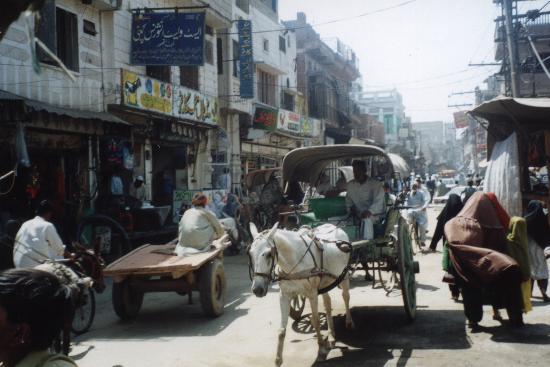 A busy street in Kasoor (a small town near Lahore)
A busy street in Kasoor (a small town near Lahore)
|
Welcome to Lahore!
Lahore, city, northeastern Pakistan, capital of Punjab Province, on the Ravi River. It is the principal commercial and banking center of the province.
|
|
|
With its refuge of shady parks and gardens, its clash of Moghul and colonial architecture, and the exotic thrill of its congested streets and bazaars, it's not hard to see why. A collection of some of the city's attractions include: The Mall, an area of parks and buildings with a decidedly British bent; Lahore Museum, the best and biggest museum in the country; Kim's Gun, the cannon immortalised in Kipling's classic Kim; Aitchison College, an achingly beautiful public school that boasts Imran Khan as a former pupil; Lahore Fort, filled with stately palaces, halls and gardens; and the Old City, where a procession of rickshaws, pony carts, hawkers and veiled women fill the narrow lanes. The city has too many tombs, mosques and mausoleums too mention.
|
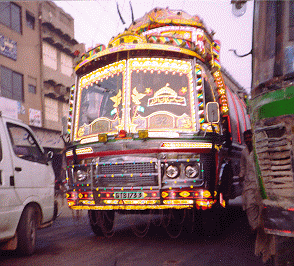 Colurful buses of Lahore
Colurful buses of Lahore
|
The traffic in Lahore is aggressive, with every traffic light removed and only suggestions of lanes. Now add unpatrolled speeds. Gruesome enough? Spice that with donkey carts, horse carriages,cars,bikes,containing the whole family in a pile rivaling a circus act, motorcycles, colourful buses, and chickens using the same road and I think you will have a full picture. We spent most of the time on chartered vans, Tanga (horse carriages) and of course, my personal favorite, 'Qingi' a motorcycle with 6 (or at times 10)passenger carrier.You would know you are back in Lahore when sounding of horns are as frequent as you say 'hello'
|
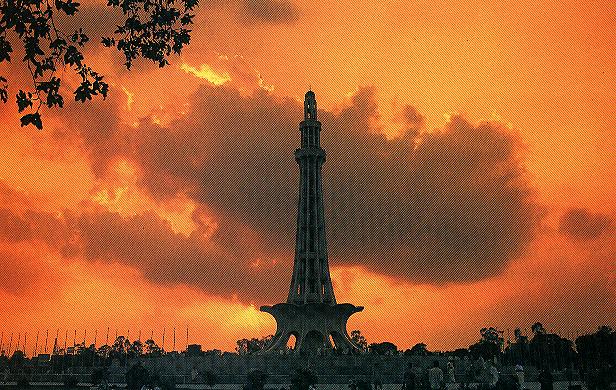 Minar - e - Pakistan
Minar - e - Pakistan
|
Lahore was a cultural and intellectual centre during both the Moghul and British eras, and it's an atmosphere which still pervades today, but it is the diversity and contrast of the different sections of the city which make Lahore interesting. Apart from local tourists with their blaring transistors, you could almost be back in the Moghul era.
Lahore is 213 metres above sea level and has a population of approximately 3 million. The temperature here drops down to 10C in winter, but in summer can soar to 40C or more. The best time to visit is straight after the monsoon period when the weather is cool and pleasant.
Although most parts of the Royal fort were constructed around 1566 AD by the Mughal Emperor, Akbar the Great, there is a evidence that a mud fort was in existence here in 1021 AD as well, when mud fort and constructed most of the modern Fort, as we see it today, on the old foundations. Constructions of the fort dates back to the early Hindu period.
|
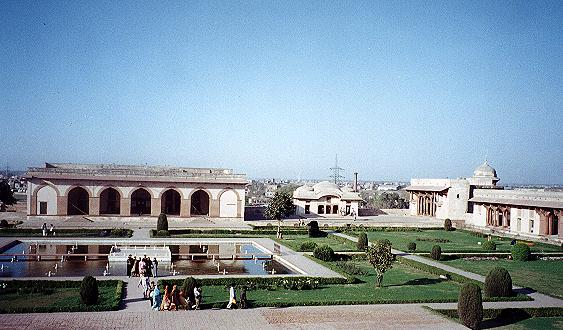 The Royal Fort
The Royal Fort
|
The Royal Fort is rectangular. The main gates are located alongside the centre of the western and eastern walls. Every succeeding Mughal Emperor as well as the Sikhs, and the British in their turn, added a pavilion, palace of wall to the Fort. Emperor Jehangir extended the gardens and constructed the palaces that we see today in the Jehangir's Quadrangle, while Shah Jehan added Diwan-e-Khas, Moti Masjid (Pearl Mosque) and his own Sleeping Chambers. Aurangzeb built the impressive main gate which faces the Hazoori Bagh lying in between the Badshahi Mosque and the fort. the famous Sheesh Mahal or Place of Mirrors, is in the north-east corner of the fort. This is the most beautiful palace in the fort and is decorated with small mirrors of different colours set.
The part of the wall of the elephant Steps towards the forts inner gate are scarred by bullet marks, bearing testimony to the Sikh Civil War of 1847 AD. A party of Sikhs had mounted their guns on one of the minarets of the mosque across the courtyard from where they fired on their opponents. the Sleeping Chamber of Mai Jindan houses a very interesting museum with relics from Mughal and the Sikh periods.
|
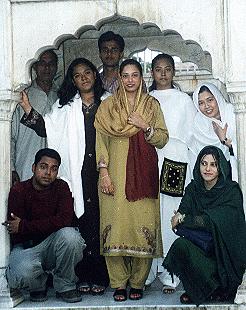 Shalimar Garden at Sunset
Shalimar Garden at Sunset
|
Shalimar Gardens laid out by the Mughal emperor Shah Jehan in 1642 AD. The Gardens are spread out in typical Mughal style and are surrounded by high walls with watch-towers at the four corners. Originally, the gardens were spread over seven ascending terraces, but only three remain now which cover an area of about 42 acres. The brick-work of the floors of the three terraces have been repaired according to their original designs which differ on all three terraces.
|
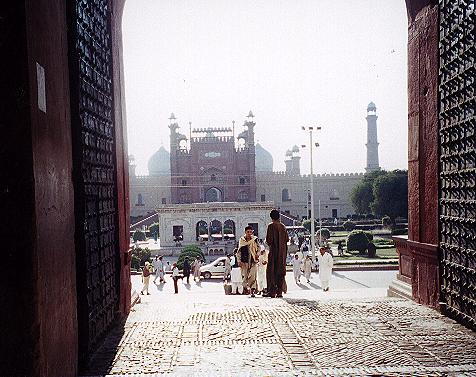 Badshahi Mosque (view from The Royal Fort)
Badshahi Mosque (view from The Royal Fort)
|
The Imperial or the Badshahi Mosque is across the courtyard from Alamgiri Gate of the Lahore Fort. The Mosque which is made up entirely of red sand-stone was built by Emperor Aurangzeb, the last of the great Mughals, in a record time of two and-a-half years. Its construction was completed by 1674 AD.
It has a beautiful gate-way which measures 21.33 metres in length and a courtyard that measures 161.5 x 160.6 metres and is said to be the largest mosque courtyard in the world for outdoor prayers. The marble domes cover seven prayer chambers. Four lofty minarets stand at the four corners of the mosque, each with an outer circumference of 20 metres, soaring up to 54 metres.
In the chambers above the Gate of the mosque, are housed relics attributed to the Holy Prophet of Islam Peace be upon him, his daughter and his son-in-law and are said to have been brought to the sub-continent by Amir Taimur.
Within the Mosque almost all the colours have been used for painting the floral designs but the overall effect remains one of sobriety, piousness and simplicity.
|
|
|
Lahore is very old. Legend traces its origin to Loh, the son of Rama Chandra, the hero of the Ramayana, but history records that it began as a dependency of the 8th century AD Hindu ruler, Lalitiditya. In the early 11th century it came under Muslim rule and evolved as a centre of Islamic culture and learning as well as trade and commerce. In the 13th century it was depopulated and razed to the ground by the Tartar-Mongol hordes of Genghis Khan. Timurlane and his Muslim Turks also arrived and destroyed the city.
|
|